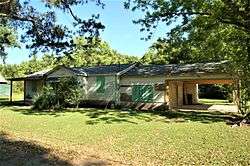Robert "Bob" Hicks House
|
Robert "Bob" Hicks House | |
 | |
  | |
| Location | 924 E. Robert "Bob" Hicks (formerly 9th) St., Bogalusa, Louisiana |
|---|---|
| Coordinates | 30°46′15″N 89°50′48″W / 30.77083°N 89.84667°WCoordinates: 30°46′15″N 89°50′48″W / 30.77083°N 89.84667°W |
| NRHP reference # | 14001174[1] |
| Added to NRHP | January 20, 2015 |
The Robert Hicks House, in Bogalusa, Louisiana, was the home from 1965-1969 of civil rights leader Robert "Bob" Hicks (1929-2010) and the site of civil rights meetings in the city.[2]
History
Hicks was a co-founder and leader of the local chapter of the Deacons for Defense and Justice, founded in February 1965 and affiliated with the original group founded in Jonesboro, Louisiana. They organized men for armed self-defense in order to protect civil rights activists and their families, under attack in those years by the Ku Klux Klan. He was also a leader of the Bogalusa Civic and Voters League (BCVL), which was seeking to register black voters.
The house was listed on the National Register of Historic Places in 2015.[1] It was deemed significant for its role in the Civil Rights Movement in Bogalusa and for its association with leader Robert Hicks. The house served as the headquarters for the executive board of the BCVL, and for the Deacons for Defense and Justice.[1]
On February 1, 1965, the house was threatened with bombing by whites seeking to intimidate the activists of the BCVL.[3] On February 21, 1965, Hicks and others founded the local chapter of the Deacons for Defense and Justice to protect activists and their families.
On May 17, 1965, Hicks participated in an attempt by blacks to use one of Bogalusa's public parks. Despite passage the previous year of the national Civil Rights Act of 1964, prohibiting segregation of public facilities, local whites continued to exclude blacks from parks and other places.[2] Confrontations continued through the summer and in July 1965, the federal government used Reconstruction-era law to order the local police to protect the civil rights activists.[3]
A historic plaque was erected at the house site. The Robert Hicks Foundation is supporting work for a civil rights museum here, to open in 2018.[4]
Description
The house, built in the early 1950s, is a one-story 1,590 square feet (148 m2) building with similarities to 1950s ranch houses and 1930s bungalows. It has weatherboard siding and is built on concrete piers. The property also includes a 1906-built "mill house" built by the Great Southern Lumber Company when it developed the company town of Bogalusa from the ground up in 1906-1907. The company built both worker and supervisory housing, as well as churches, schools, hotels, and YMCA/YWCA. Through the 1930s, a sawmill and paper mills operated here to harvest the virgin pine timber. The paper mills and chemical operations continued in the industrial city. The population was at its peak of 21,000 in 1960.[2] The house is located on what was known as East Ninth Street, which was renamed on August 28, 2010.[2]
References
- 1 2 3 Robert "Bob" Hicks House, at National Park Service
- 1 2 3 4 Barbara Hicks-Collins (August 29, 2014). "National Register of Historic Places Registration: Robert "Bob" Hicks House" (PDF). National Park Service. Retrieved May 7, 2017. Includes 35 photos from 2014 and 18 historic photos and other illustrations.
- 1 2 Douglas Martin (April 24, 2010). "Robert Hicks, Leader in Armed Rights Group, Dies at 81". New York Times.
- ↑ "Civil Rights Museum".
Further reading
- Adam Fairclough, Race and Democracy: The Civil Rights Struggle in Louisiana, 1915-1972, University of Georgia Press, 1995/reprint 1999
- Hill, Lance E. (2004). The Deacons for Defense: Armed Resistance and the Civil Rights Movement (1 ed.). Chapel Hill: University of North Carolina Press. ISBN 9780807828472.
External links
- Civil Rights Museum, Robert Hicks Foundation